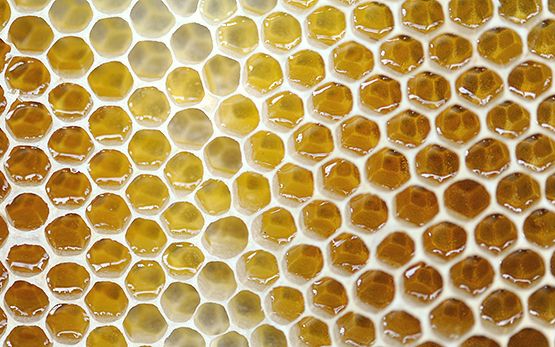Der Wassergehalt des von den Pflanzen produzierten Nektars kann variieren. Um seine Konservierung in den Waben zu gewährleisten, darf er nicht gären. Deshalb wird er von den Bienen in Honig umgewandelt, indem sie seinen Wassergehalt senken und folglich den Zuckergehalt erhöhen. Dies verhindert die Entwicklung der Mikroorganismen. In der Dunkelheit des Bienenstocks ist es schwierig, den Herstellungsprozess des Honigs zu beobachten. Aus diesem Grund ist er auch nur wenig erforscht. Um die Umwandlung von Nektar in Honig zu untersuchen, haben wir die Technik der Tomographie eingesetzt. Sie ermöglicht es, den Zuckergehalt des eingelagerten Nektars sehr präzise zu messen, ohne den Bienenstock öffnen zu müssen und das Bienenvolk zu stören.

Pubblicazioni Susanne Vogelgsang
Romero Blanch F., Cazzato S., Walder F., Vogelgsang S., Bender S. F., van der Heijden M.
Humidity and high temperature are important for predicting fungal disease outbreaks worldwide.
New Phytologist, online, (13 March), 2021.
Drakopoulos D., Sulyok M., Krska R., Logrieco A. F., Vogelgsang S.
Raised concerns about the safety of barley grains and straw: A Swiss survey reveals a high diversity of mycotoxins and other fungal metabolites.
Food Control, 125, 2021.
Drakopoulos D., Sulyok M., Jenny E., Kägi A., Bänziger I., Logrieco A. F., Krska R., Vogelgsang S.
Fusarium head blight and associated mycotoxins in grains and straw of barley: Influence of agricultural practices.
Agronomy, 11, (4), 2021, 1-23.
Drakopoulos D., Kägi A., Six J., Zorn A., Wettstein F., Bucheli T., Forrer HR, Vogelgsang S.
The agronomic and economic viability of innovative cropping systems to reduce Fusarium head blight and related mycotoxins in wheat.
Agricultural Systems, 192, 2021, Articolo 103198.
Pallez-Barthel M., Cocco E., Vogelgsang S., Beyer M.
Frequency of deoxynivalenol concentrations above the maximum limit in raw winter wheat grain during a 12-year multi-site survey.
Agronomy, 11, (5), 2021, 1-13.
Drakopoulos D., Gimeno Sierra A., Kägi A., Jenny E., Bänziger I., Musa T., Forrer H.-R., Vogelgsang S.
Innovative Anbausysteme zur Reduktion von Fusarium- Mykotoxinen in Weizen.
Agrarforschung Schweiz, 12, 2021, 16-23.
altre lingue:
de Jong A.-V., Buchmann J., Seiler A., Masson S., Steinger T., Vogelgsang S., Zorn A., Wirth J., Jeanneret P.
PestiRed – Agrarökologie und Co‐Innovation als Ansatz zur Reduktion des Pflanzenschutzmitteleinsatzes.
In: Journée phytosanitaire Grandes Cultures. 19.01., Ed. Agroscope, Online. 2021, 1-16.
Gimeno Sierra A., Drakopoulos D., Kägi A., Vogelgsang S.
Ein natürlicher Gegenspieler.
UFA-Revue, 11, 2020, 38-39.
altre lingue:
Drakopoulos D., Gimeno Sierra A., Kägi A., Vogelgsang S.
«Cut-and-carry»-Biofumigation: Natürliche Reduktion von Fusarium-Mykotoxinen.
UFA-Revue, 11, 2020, 34-36.
altre lingue:
Katrin Erfurt, Vogelgsang S.
Bodenpilz gegen Fusarien gefunden.
BauernZeitung, Online, (20. November), 2020, 33.
Sullam K., Bänziger I., Kägi A., Jenny E., Klaus S., Vogelgsang S., Büttner-Mainik A., Hebeisen T.
Strategien zur Bekämpfung des Gersten-Flugbrands.
In: NBFF-Tagung 2020. 04. Dezember, Zoom. 2020, 1-19.
Drakopoulos D., Gimeno Sierra A., Kägi A., Vogelgsang S.
Biofumigation «cut-and-carry»: Réduction naturelle des mycotoxines de Fusarium dans le blé.
Revue UFA, 11, 2020, 34-36.
Drakopoulos D., Meca G., Torrijos R., Marty A., Kägi A., Jenny E., Forrer H.-R., Six J., Vogelgsang S.
Control of Fusarium graminearum in wheat with mustard-based botanicals: from in vitro to in planta.
Frontiers in Microbiology, 11, 2020, 1-15.
Gimeno Sierra A., Kägi A., Drakopoulos D., Bänziger I., Lehmann E., Forrer H.-R., Keller B., Vogelgsang S.
From laboratory to the field: biological control of Fusarium graminearum on infected maize crop residues.
Journal of Applied Microbiology, online, (16 March), 2020, 1-15.
Wirth J., Steinger T., Vogelgsang S., Zorn A., Jeanneret P.
PestiRed: A Swiss on-farm approach to reduce pesticide use in arable crops.
In: 29. Deutsche Arbeitsbesprechung über Fragen der Unkrautbiologie und -bekämpfung. 3.-5. März, Ed. Henning Nordmeyer, Lena Ulber, Braunschweig. 2020, 290-294.
Drakopoulos D., Kägi A., Gimeno A., Six J., Jenny E., Forrer H.-R., Musa T., Giuseppe M., Vogelgsang S.
Prevention of Fusarium head blight infection and mycotoxins in wheat with cut-and-carry biofumigation and botanicals.
Field Crops Research, 246, ((Article number 107681)), 2019, 1-9.
Drakopoulos D., Luz C., Torrijos R., Meca G., Weber P., Bänziger I., Voegele R. T., Six J., Vogelgsang S.
Use of Botanicals to Suppress Different Stages of the Life Cycle of Fusarium graminearum.
Phytopathology, online, (10 October), 2019, 1-8.
Vogelgsang S., Gaume A., Logrieco A. F.
Prevention and integrated control of mycotoxins in wheat, barley and maize.
In: The 3rd MycoKey technological workshop. 18-19 June, Ed. Agroscope, Zurich. 2019, 1-48.
Gimeno Sierra A., Sohlberg E., Pakula T., Limnell J., Keller B., Laitila A., Vogelgsang S.
TaqMan qPCR for Quantification of Clonostachys rosea Used as a Biological Control Agent Against Fusarium graminearum.
Frontiers in Microbiology, online, (16 July), 2019, 1-11.
Vogelgsang S., Jenny E., Musa T., Bucheli T., Wettstein F., Forrer H.-R.
An eight-year survey of wheat shows distinctive effects of cropping factors on different Fusarium species and associated mycotoxins.
In: International Commission on Food Mycology conference. 3 June, Ed. ICFM, Freising. 2019, 1.





